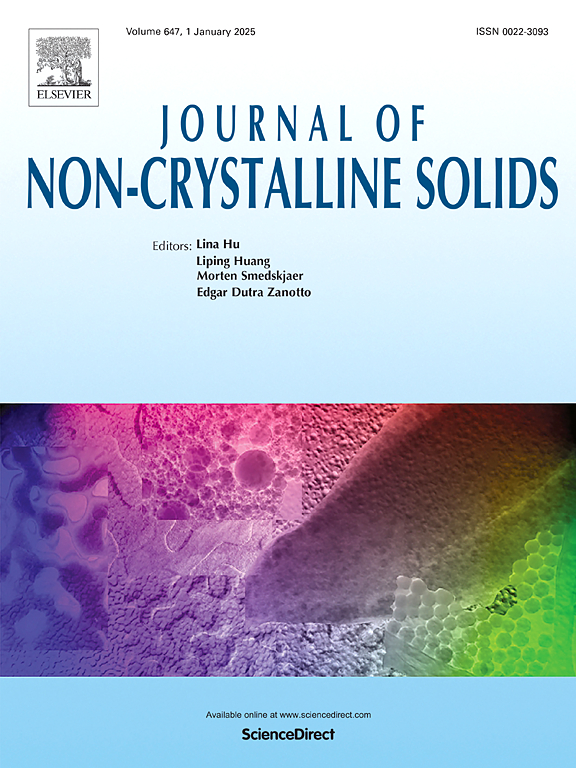添加Ge对S-Se-Pb硫系玻璃物理、光学和力学性能的影响
IF 3.5
3区 材料科学
Q1 MATERIALS SCIENCE, CERAMICS
引用次数: 0
摘要
采用熔融淬火技术合成了一系列新的含锗硫系S-Se-Pb玻璃。合成化合物的无定形性质已通过x射线衍射进行了检验。测得的密度从(3.02-3.54)g增加。cm-3由于掺入了Ge原子。估计光能带隙从(2.04 ~ 1.71)eV减小,而厄巴赫能从(0.16 ~ 0.35)eV增大,显示出结构无序的表现。采用Wemple-Di Domenico模型进行色散分析。计算并系统地解释了复杂的介电常数、耗散因子和损耗函数,即VELF和SELF参数。所研究的玻璃样品的弹性模量是由测量的纵向和横向速度得到的。研究发现,随着Ge原子的增加,纵向模量从(22.87 ~ 37.85)GPa和杨氏模量从(19.01 ~ 32.05)GPa急剧增加。由Bond压缩模型得到的弹性模量的理论值与实验结果吻合较好。研究结果表明,在所研究的样品中,S(50−x)Se₄₀Pb₁₀Geₓ(x = 20)样品具有最佳的光学特性和最高的机械稳定性,可用于光电应用。本文章由计算机程序翻译,如有差异,请以英文原文为准。
Influence of Ge Addition on physical, optical, and mechanical properties of S-Se-Pb chalcogenide glasses
A new series of Ge-incorporated chalcogenide S-Se-Pb glasses is synthesized by the melt-quenching technique. The amorphous nature of the synthesized compounds has been checked by X-ray diffraction. The measured density increases from (3.02-3.54)g.cm-3 due to the incorporation of Ge atoms. The estimated optical energy band gap decreases from (2.04-1.71) eV, whereas the Urbach energy increases from (0.16- 0.35) eV, demonstrating the manifestation of structural disorder. The Wemple-Di Domenico model is deployed for the dispersion analysis. The complex dielectric constant, dissipation factor, and loss functions, i.e., VELF and SELF parameters, are computed and systematically interpreted. Elastic moduli of the studied glass samples are obtained from the measured longitudinal and transverse velocities. The study reveals an upsurge in longitudinal modulus from (22.87 – 37.85) GPa and Young’s modulus from (19.01-32.05) GPa with increasing Ge atoms. Theoretical values of elastic moduli acquired from Bond compression model are in agreement with the experimentally obtained results. The obtained findings suggest that among all the studied samples, the S(50−x)Se₄₀Pb₁₀Geₓ (x = 20) sample has the best optical features and highest mechanical stability, which can be used for optoelectronic applications.
求助全文
通过发布文献求助,成功后即可免费获取论文全文。
去求助
来源期刊

Journal of Non-crystalline Solids
工程技术-材料科学:硅酸盐
CiteScore
6.50
自引率
11.40%
发文量
576
审稿时长
35 days
期刊介绍:
The Journal of Non-Crystalline Solids publishes review articles, research papers, and Letters to the Editor on amorphous and glassy materials, including inorganic, organic, polymeric, hybrid and metallic systems. Papers on partially glassy materials, such as glass-ceramics and glass-matrix composites, and papers involving the liquid state are also included in so far as the properties of the liquid are relevant for the formation of the solid.
In all cases the papers must demonstrate both novelty and importance to the field, by way of significant advances in understanding or application of non-crystalline solids; in the case of Letters, a compelling case must also be made for expedited handling.
 求助内容:
求助内容: 应助结果提醒方式:
应助结果提醒方式:


